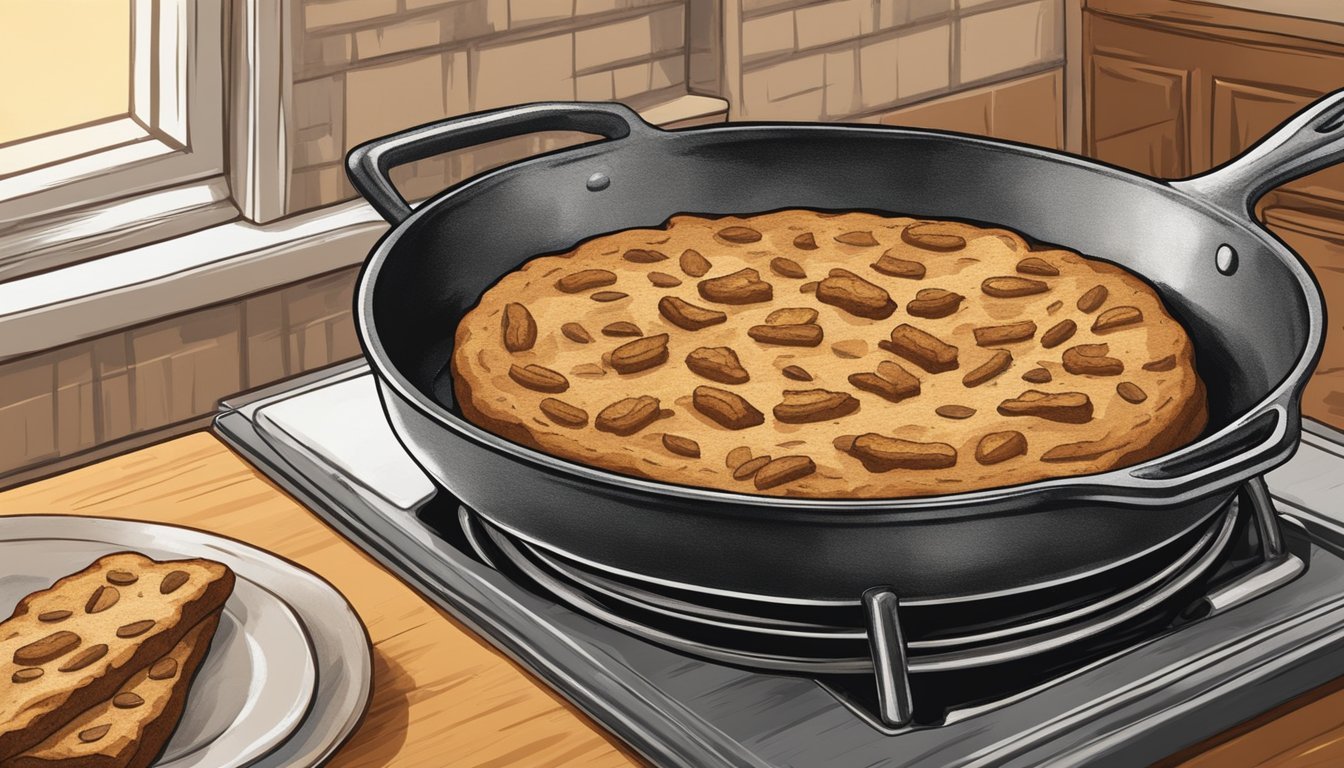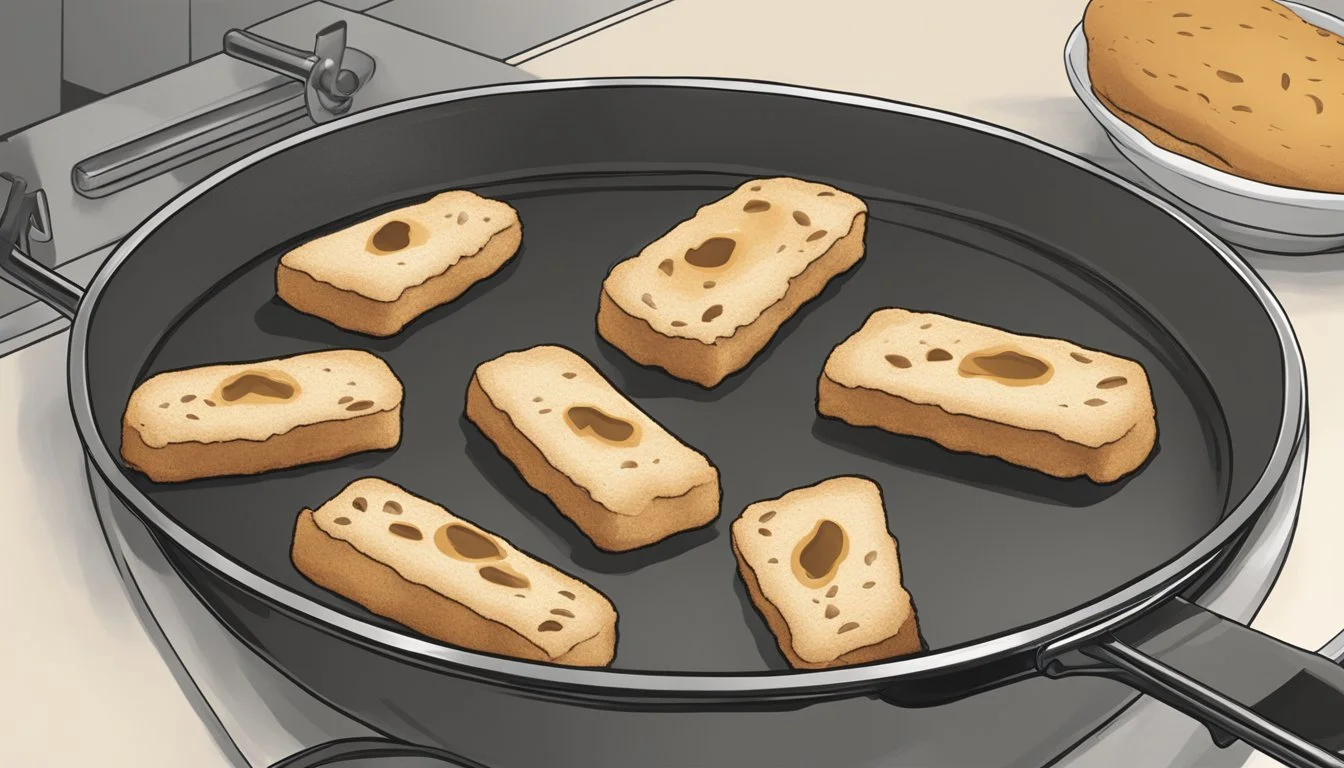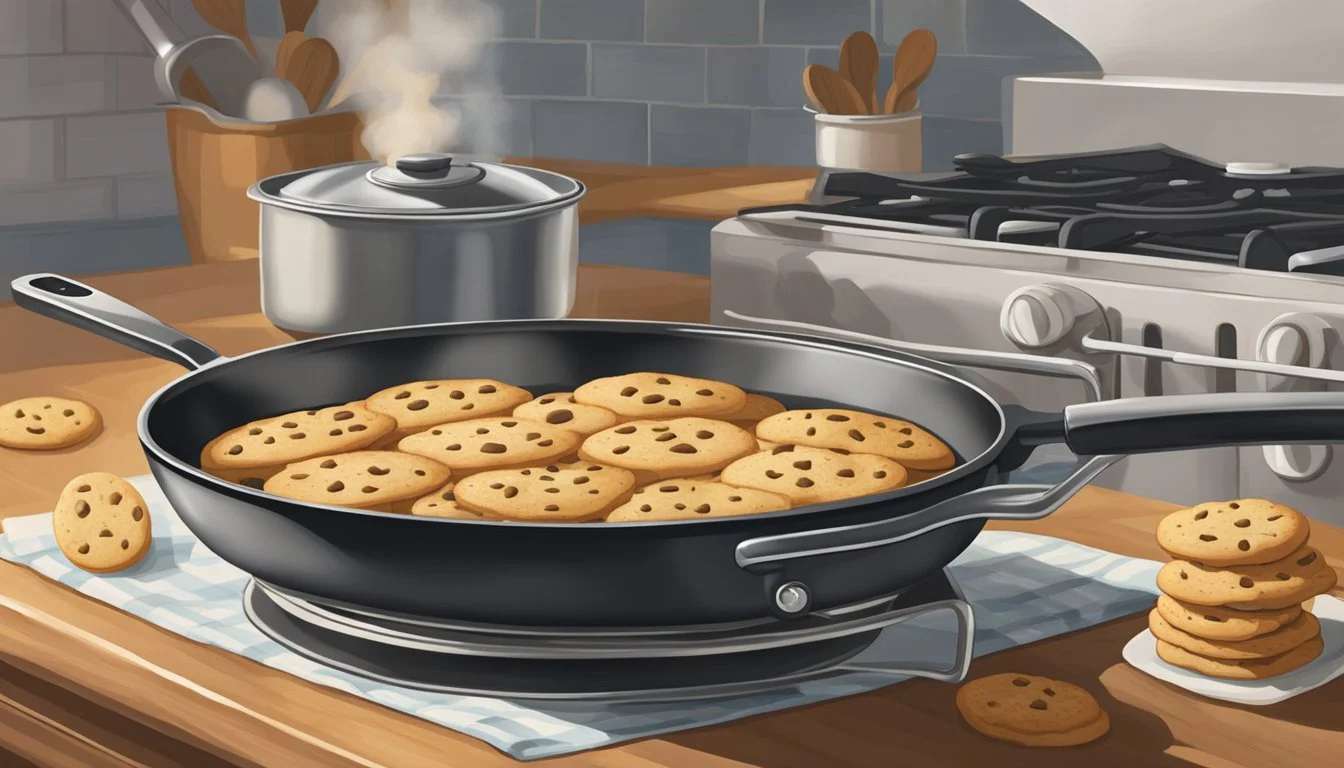The Skillet Biscotti
Mastering Stovetop Twice-Baked Cookies
Biscotti, the quintessential Italian cookie, is traditionally known for its crunchy texture and delightful flavors, often enhanced with nuts, dried fruit, or chocolate (What wine goes well with chocolate?) chips. Known for its twice-baked process in ovens that results in a dry and crisp quality, biscotti has been a favorite accompaniment to coffee and tea around the world. With its origins dating back to Roman times, this cookie was originally designed to be durable, and its lack of moisture allowed it to be stored for long periods.
However, innovation in the kitchen does not stand still, and the skillet biscotti emerges as a modern twist on the classic oven-baked treat. The skillet method offers a novel way to achieve the characteristic texture and toasted flavor of biscotti, all while using a stovetop. This approach is not only intriguing for those with oven constraints but also promises a quicker, yet equally satisfying experience in creating the crunchy delight. The process of skillet-baking still encapsulates the art of twice-cooking the biscotti, paying homage to the cookie's storied history, but doing so in a pan over the flame.
The Origins of Biscotti
Biscotti, the Italian cookie known for its hard, dry texture, is historically significant due to its twice-baked cooking process. These durable cookies have played a role in the culinary practices of Italy for centuries.
Italian Cookie Tradition
Biscotti's legacy begins with the Latin roots of its name—bis, meaning twice, and coctus, cooked. The cooking method, where the dough undergoes two rounds of baking, historically allowed for creating a cookie with a long shelf life. Twice-baked by nature, the biscotti were an evolution of convenience food in Roman times, crafted for long journeys and extended storage due to their low moisture content.
The tradition of baking biscotti continued through the centuries in Italy, establishing the treat as a cornerstone in Italian culture. The confection's simple ingredients—typically flour, sugar, eggs, and nuts—helped its popularity to endure, growing synonymous with Italian hospitality and often paired with drinks like vin santo for dipping.
Tuscany's Cantucci
Cantucci, one variety of biscotti, hail from Tuscany and are distinguished by the addition of almonds. Unlike the name "biscotti," which is used generally to describe any twice-baked cookies in the Italian language, "cantucci" specifically refers to the almond biscotti of the Tuscan region. These cookies are smaller than some other biscotti and traditionally enjoyed as a dessert, dipped into a glass of vin santo, a sweet Tuscan dessert wine. The pairing of cantucci and vin santo has become emblematic of Tuscan hospitality, with the wine's sweetness complementing the cookie's crunch.
Understanding Biscotti
Biscotti, an Italian cookie known for its dry and crunchy texture, is unique due to its cooking method. This section explores the qualities that set biscotti apart from other cookies, focusing particularly on their defining characteristics.
Defining the Twice-Baked Cookie
Biscotti, deriving from the Italian word "biscotti" meaning twice-baked, undergo a distinctive two-step baking process. The dough is first shaped into logs and baked until it sets. Then, it is sliced into individual cookies and baked a second time to achieve their trademark dry and crunchy texture. This method not only imparts a crunchy texture ideal for dipping into beverages like coffee or wine but also extends the cookie's shelf life, making biscotti a convenient and enduring dessert option.
First Bake: Dough is shaped into a log and baked to set.
Second Bake: The baked log is sliced and the cookies are baked again to become dry and crunchy.
Biscotti vs. Other Cookies
In comparison to other cookies, biscotti distinction lies not just in the twice-baked technique but also in their typically lower fat content. Whereas many cookies, such as chocolate chip or oatmeal raisin, are soft and chewy due to the presence of higher amounts of butter or oil, biscotti recipes traditionally use less fat. This factor contributes hugely to their firmer texture after the second bake. Additionally, biscotti cookies often include nuts, such as almonds or pistachios, infusing flavor and adding to their signature crunchiness.
Texture: Biscotti are crisp and dry, while other cookies can be soft and moist.
Fat Content: Biscotti generally have less fat, contributing to their crunchy texture.
Flavors: Incorporating ingredients like nuts or anise seeds adds a unique taste specific to Italian cookies.
Biscotti Ingredients
Biscotti ingredients form the foundation for these delightfully crunchy cookies. Proper proportions and quality components are vital for the perfect texture and taste.
Common Base Ingredients
The base ingredients for biscotti include the following:
Sugar: Typically, 2 cups are used for sweetness and browning.
Flour: Essential for the structure; about 3-4 cups.
Eggs: They bind the ingredients together, usually 3-4.
Butter: Melted butter, around 1 cup, adds richness.
Baking Powder: A teaspoon or so ensures a light texture.
Salt: A pinch to balance the flavors.
Flavor Enhancers and Add-Ins
To elevate the basic biscotti recipe, these add-ins provide a burst of flavor:
Vanilla: A classic choice for depth of flavor. Two teaspoons of extract or the seeds from one vanilla bean can be used.
Almonds: Often a key ingredient in traditional recipes, they provide a nutty taste and crunch.
Chocolate: Either integrated into the dough or for dipping, chocolate enhances the biscotti with a sweet and creamy note.
Anise: For a hint of licorice, a quarter cup of anise seeds, anisette, or flavoring.
Nuts and Dried Fruit: Options like pistachios, hazelnuts, or cranberries introduce different textures and tastes.
Chocolate Chips: A sweeter take on biscotti, they melt slightly during the second bake.
Preparing the Dough
Preparing the dough for skillet biscotti involves accurate measuring of ingredients and careful mixing to create the right consistency. The dough should be shaped properly to facilitate even cooking on the stove.
Mixing Techniques
One begins by measuring the ingredients precisely, ensuring that the sugar and butter are at room temperature for optimal blending. Ingredients are typically combined in stages; first, the wet ingredients including melted butter and flavorings like vanilla or anise, and then the dry ingredients like flour, sugar, and leavening agents. It's crucial to mix until just combined to avoid overworking the dough, which can result in tough biscotti.
Wet Ingredients: Combine butter and sugar until creamy.
Dry Ingredients: Gently incorporate the flour, baking powder, and any spices or flavorings.
Shaping and Chilling
After mixing, the dough will likely be quite sticky and needs to be shaped into a rectangle before chilling. Flour your hands and work surface generously to prevent sticking and shape the dough into a log or rectangle, approximately 8 inches long and 4 inches wide. This is necessary for uniform biscotti pieces. Once shaped, the dough should be chilled to firm up, making it easier to handle and transfer to the skillet.
Shape the Dough: Form into a rectangle, the shape required for traditional biscotti.
Chill: Cover and chill the dough until firm, ideally in a refrigerator, to ensure ease of handling during the next steps.
Baking the Biscotti
In the transformation of dough into biscotti, the baking process is pivotal. It involves a two-stage baking method that gives these Italian cookies their distinctive dry and crunchy texture.
First Bake
To begin, preheat the oven to 350°F (175°C) and prepare the cookie sheets by lining them with parchment paper. This ensures easy removal of the biscotti logs after the first bake. Combine dry ingredients including baking powder in a consistent mixture before incorporating wet ingredients to form dough. Shape the dough into logs and place them onto the prepared sheets. The logs should be evenly spaced to allow for proper heat circulation. Bake until the logs are firm and golden brown. This typically takes about 25-30 minutes.
Creating the Slices
Once baked, let the logs cool on a wire rack for a few minutes to ensure they are firm enough to cut without crumbling. Using a serrated knife, slice the logs at a diagonal to create individual biscotti pieces approximately 1/2 inch thick. The precision in slicing is crucial for even baking in the next phase.
Second Bake
After slicing, lay the individual biscotti flat on the cookie sheets. Preheat the oven again, this time to a lower temperature of 275°F (135°C), as the second bake aims to dry the biscotti rather than cook them through. Bake for an additional 10-12 minutes, then turn the slices over to ensure even drying. They should feel dry to the touch and firm up as they cool. Once the second bake is complete, place the biscotti back on the wire rack to cool completely. The result is a twice-baked, crisp, and hearty cookie perfect for dunking.
Customizing Biscotti Flavors
Crafting the perfect biscotti entails selecting the right combination of flavors and add-ins to suit individual tastes. This creativity in flavoring is central to both traditional and innovative biscotti recipes.
Traditional Italian Flavors
Italian biscotti, known for their crunchy texture and nuanced flavors, often incorporate almonds and anise. A classic recipe might entail a simple dough flavored with anise seeds or anisette, complemented by whole or sliced almonds. For a sweeter touch, vanilla is sometimes used as a substitute for anise.
Anise Biscotti: Melted butter, sugar, anise flavoring, and whole or chopped almonds.
Almond-Vanilla Biscotti: Almond flour blended with all-purpose flour and a hint of vanilla essence.
Innovative Combinations
Contemporary biscotti recipes encourage experimentation with a vast array of ingredients, pushing the boundaries of traditional flavors. Adventurous bakers might integrate dark chocolate chips or white chocolate pieces for a rich twist. Cranberries and pistachios can be added for a tart and nutty combination, while ginger and walnuts create a warmly spiced cookie with a satisfying crunch.
Cranberry and White Chocolate Biscotti: Infuse your dough with tangy dried cranberries and sweet white chocolate chips.
Spiced Ginger Walnut Biscotti: Mix in finely chopped candied ginger and roasted walnuts for added texture and warmth.
Serving and Pairing Biscotti
Biscotti, a classic Italian cookie traditionally enjoyed as a dunkable treat, pairs exceptionally well with beverages and can be elegantly combined with wines as a sophisticated dessert option.
Coffee and Tea Companions
Coffee or tea serving with biscotti is an age-old tradition. The biscotti's firm texture is ideal for dunking into a hot beverage, absorbing the flavors without falling apart.
Coffee: A bold espresso or a creamy latte provides the perfect contrast to the crunchy texture of biscotti.
Tea: A warm cup of black tea or the subtle aromas of herbal tea complement the sweet and nutty notes of the cookies.
Wine and Dessert Options
When serving biscotti as a dessert, pairing them with wine elevates the experience.
Vin Santo: This sweet Italian dessert wine is a classic choice for dunking biscotti.
Wine Pairings:
Light almond biscotti: Pair with a refreshing Moscato.
Chocolate-infused biscotti: Opt for a bold, sweet Port to enrich the flavor.
Storing and Enjoying Biscotti
To keep biscotti fresh and crunchy, proper storage is essential. These twice-baked cookies can be the highlight of one's day or a delightful gift for the community when preserved correctly.
Maintaining Freshness
Storing Biscotti:
Freshness: Biscotti remains fresh when stored in an airtight container.
Location: Place the container in a cool, dry area to avoid moisture buildup which could lead to softness.
Moisture Control: Line the container with a paper towel to absorb any excess moisture.
Temperature: Room temperature is ideal for up to a month, while freezing can extend their freshness up to three months.
Homemade Biscotti as a Gift
Packaging for Presentation:
Airtight Container: Choose a container that seals well to maintain the biscotti's freshness.
Personal Touch: Add a ribbon or a custom label to the container for a special touch.
Homemade and Thoughtful:
Biscotti packaged neatly showcases one's effort and care, making them an excellent gift for others in the community.
Emphasize the biscotti's homemade origin to highlight the personal touch of the gift.
Advanced Biscotti Making Techniques
When one masters the basic recipe of biscotti, exploring advanced techniques can enhance flavor and texture. This includes experimenting with chocolate dipping and incorporating various nuts and fruits which can add complexity and a personal touch to the traditional biscotti.
Chocolate Dipping
The technique of dipping biscotti in chocolate elevates the simple cookie to a gourmet treat. One can melt chocolate using a double boiler method or a microwave. When using a microwave, it's crucial to heat the chocolate in short intervals, stirring in between to avoid scorching. Once melted, dip half of the biscotti lengthwise into the chocolate, laying them on parchment paper to set. For a more decadent approach, use white chocolate chips or dark chocolate and sprinkle with crushed pistachios, hazelnuts, or walnuts for added texture and a sophisticated touch.
Nut and Fruit Variations
Incorporating nuts and fruits is an excellent way for bakers to get creative. Adding cranberry pistachio or dried cherries paired with pecans can create a harmonious balance of tartness and richness in the cookie. The key is to fold these add-ins into the dough just before shaping, ensuring an even distribution. One technique is to toast the nuts beforehand to intensify their flavor and crunch. Toasted nuts can be folded into the dough or pressed onto the surface before the first bake for an appealing look and taste.









